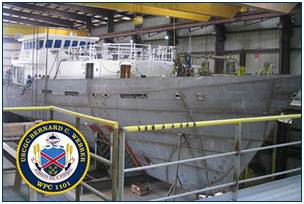Second Sentinel-Class Cutter Contract Option Awarded
The Coast Guard awarded a $166.1m contract option to Bollinger Shipyards of Lockport, La., on September 14 to begin production of four Sentinel-class Fast Response Cutters (FRCs). This option award brings the total number of FRCs under contract with Bollinger to eight with a current contract value of $410.7 million. The current FRC contract contains options for up to 34 cutters and is worth up to $1.5 billion if all options are exercised.
In September 2008, the Coast Guard awarded Bollinger an $88m production contract for the lead FRC. That ship, named the Bernard C. Webber, is approximately 70% complete and expected to be delivered to the Coast Guard in the third quarter of fiscal year 2011. The Bernard C. Webber will be homeported in Miami, Fla., supporting vital law enforcement and national security missions throughout the Caribbean and Gulf of Mexico.
This first contract option, for construction of three more FRCs, was awarded to Bollinger in December 2009; those ships are currently under construction at Bollinger’s shipbuilding facility in Lockport. The second FRC is approximately 40% complete; FRCs three and four are 15% and 1% complete, respectively.
The Sentinel-class will eventually replace the Coast Guard’s Island-class 110-ft patrol boat. The FRC uses a proven, in-service parent craft design based on the Damen Stan Patrol 4708. It has a required flank speed of 28 knots and will be armed with one stabilized, remotely-operated 25mm chain gun and four crew-served .50 caliber machine guns. Other requirements include the ability to perform independently for a minimum of five days at sea and capable of underway operations for a minimum of 2,500 hours per year. It will use state-of-the-market command, control, communications and computer technology that will be interoperable with the Coast Guard’s existing and future assets, as well as Department of Homeland Security and Department of Defense assets. The cutter will also meet American Bureau of Shipping design, build and class standards. The Coast Guard plans to build 58 FRCs.













